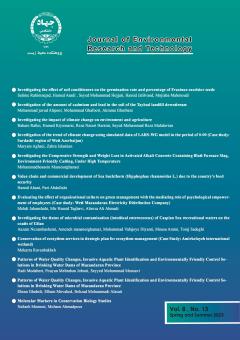-
-
-
Open Access Article
1 - Cheese whey recycling, the right approach to prevent environmental damage
Zahra Katabehei Moradi Maryam Haghighi khomami Hamed Kioumarsi hooshang dehghanzadeh saeed tamadoni jahromiToday, with increasing in production and diversity expansion of dairy products in factories and production of whey products, this food product has become very important. Whey is a water-soluble part of milk that is obtained by adding acid, heating, and coagulating the c MoreToday, with increasing in production and diversity expansion of dairy products in factories and production of whey products, this food product has become very important. Whey is a water-soluble part of milk that is obtained by adding acid, heating, and coagulating the cheese. This yellow liquid contains a lot of lactose and mineral compounds such as calcium and phosphorus, which is important to achieve in order to use as a food source and prevent environmental pollution. Since the wastewaters of the dairy industry have the highest levels of contamination, if the untreated wastewaters of this industry are discharged, serious environmental problems will be inevitable. On the other hand, a reduction in existing reserves and environmental problems followed by increasing use of fossil fuels has prompted researchers to produce new sources of renewable energy, and it can be said that new biological technologies, such as the use of whey as a way to produce biofuels, reduces the environmental problems of dischrging this kind of wastewaters into nature. Today, using biological technology, these compounds can be used to produce biofuels such as hydrogen, methane, and ethanol. So far, various methods and tests have been performed to produce these fuel sources and in this study, the effective strategies for recycling whey and preventing environmental damages are investigated. Manuscript profile -
Open Access Article
2 - Investigation of Congored dye removal from industrial waste water using adsorption method
Mohadeseh Tavakoli niloofar AbedinzadeThese days, the removal of various dyes from industrial wastewater has become an important concern. Synthetic dyes used in industries such as textiles are complex, toxic and mutant organic materials. Congored is also an acidic dye that is considered a high- risk source MoreThese days, the removal of various dyes from industrial wastewater has become an important concern. Synthetic dyes used in industries such as textiles are complex, toxic and mutant organic materials. Congored is also an acidic dye that is considered a high- risk source of contamination and threatens the lives of humans and other living organisms. Different methods, such as electrochemical, physical and biological processes, are used to remove organic pigment from aqueous samples. Adsorption is one of the most effective modern methods of industrial wastewater treatment, which is a relatively simple and inexpensive process that produces non- toxic and low- risk products. The purpose of this study is removing the Congored dye from aqueous solutions and reviewing the accomplished researches for remove it. Manuscript profile -
Open Access Article
3 - Investigation of pollution index parameters in the effluent of wastewater treatment plants in industrial towns of Guilan province
Mohammad Yazdi Hanieh MirbolookiNowadays, the importance of water is known more than before as a life factor and the axis of sustainable development that to protect and manage it, it needs to be controlled using laboratory tests and regular monitoring program. The purpose of this study was to investig MoreNowadays, the importance of water is known more than before as a life factor and the axis of sustainable development that to protect and manage it, it needs to be controlled using laboratory tests and regular monitoring program. The purpose of this study was to investigate the treatment plant effluent of three large industrial towns in Gilan province and comparing the index parameters with Environmental Protection Organization standards; the measured parameter included pH, TDS, DO, COD and BOD5. The results showed that, some index parameters in the treatment plant effluent in some industrial towns were more than the approved discharge standards to the receiving environments which indicates the necessity of paying attention to regular monitoring and investigation of wastewater treatment systems in industrial towns more than before. Manuscript profile -
Open Access Article
4 - Removal of lead with metallic organic nanostructures of iron and benzene tricarboxylate from aqueous solution
reza alizadehHeavy metals are not chemically degraded, in order to prevent the entry and accumulation of this toxic pollutant along with factory effluents into the environment, so far, different methods have been used, but finding new methods with more efficiency in this area is nec MoreHeavy metals are not chemically degraded, in order to prevent the entry and accumulation of this toxic pollutant along with factory effluents into the environment, so far, different methods have been used, but finding new methods with more efficiency in this area is necessary. In this research, a new class of compounds called organic metallic materials has been used to remove industrial effluent lead. These organic metallic materials contain iron and benzene tricarboxylate. To identify the characteristics of these materials, electron microscope images and Nitrogen adsorption and desorption isotherms has been used. To determine the optimal conditions for using these materials for lead removal from the effluent, the effect of parameters: time (10-120 min), the amount of adsorbent (0.2-0.5 mg/L), pH (3.5 -12.5) and temperature (10-75 ° C) were evaluated. The results show that the composition of MIL-100 (Fe) has a better performance than the other materials in this study and complete removal of lead was achieved with an initial concentration of 10 mg/l and an adsorbent dose of 0.25 mg / l, at a temperature of 50 ° C, pH =4.3 and contact time of 120 min. Other properties of this material in removal of industrial effluent lead such as magnetic properties, reusability in five consecutive periods, large surface area, low cost, high efficiency and easy to use, make it an ideal option for large-scale use. Manuscript profile
List of Articles پساب
-
The rights to this website are owned by the Raimag Press Management System.
Copyright © 2017-2024


